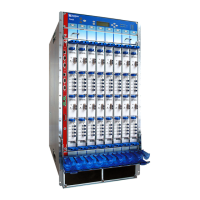the color coding for the leads on the power cables that attach to the
terminal studs on each power supply.
7. Secure the cable lugs to the terminal studs, first with a washer, then with a nut (see
Figure 182 on page 365).
a. Attach the positive (+) DC source power cable lugs to the RETURN (return)
terminals.
b. Attach the negative (–) DC source power cable lugs to the –48V (input) terminals.
Use a 7/16-in. (11 mm) nut driver or wrench to tighten the nut. Apply between 23 lb-in.
(2.6 Nm) and 25 lb-in. (2.8 Nm) of torque to each nut.
NOTE: For power supplies set to 2-INPUT mode (required for the T640
router and TX Matrix router), connect two DC power cables, one for
RETURN and one for –48 V to INPUT 0 and two DC power cables, one for
RETURN and one for –48 V to INPUT 1.
NOTE: INPUT 0 and INPUT 1 on the three-input 240-A DC power supply
in slot PEM0 must be powered by dedicated power feeds derived from
feed A, and INPUT 0 and INPUT 1 on the three-input240-A DC power supply
in slot PEM1 must be poweredby dedicated powerfeeds derivedfrom feed
B. This configuration provides the commonly deployed A/B feed
redundancy for the system.
8. Loosen the captive screw or screws on the cable restraint on the right edge of the
power supply faceplate.
9. Route the DC power cables through the cable restraint.
10. Tighten the cable restraint captive screw or screws to hold the power cables in place.
11. Verify that the power cabling is correct, that the power cables are not touching or
blocking access to other hardware components, and that they do not drape where
people could trip on them.
12. Replace the clear plastic cover over the terminal studs on the faceplate.
Copyright © 2017, Juniper Networks, Inc.364
T640 Core Router Hardware Guide

